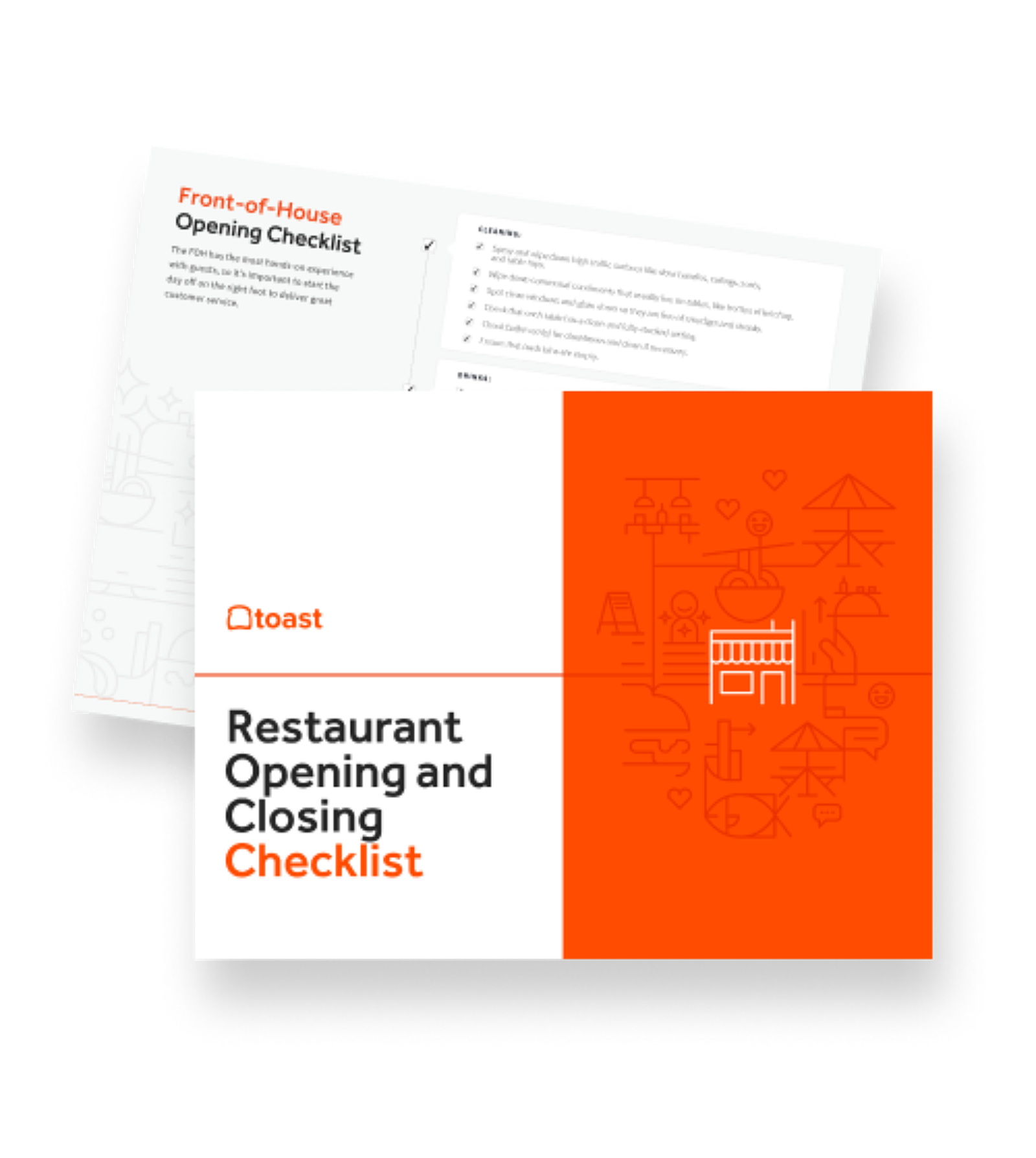
How to Franchise a Restaurant: A Complete 2024 Guide
Ready to bring your restaurant to the world? Here’s a complete guide on how to franchise a restaurant.

Nick PerryAuthor


Restaurant Opening and Closing Checklist
The beginning and end of a shift can be frantic. Use this free PDF checklist to set your front-of-house staff up for success.
The most ambitious restaurateurs want to bring their culinary creations to as many people as possible. That means opening more locations. But if you’re especially ambitious and you believe there’s tremendous demand for your food, you may consider franchising.
Many of the world’s most famous restaurants are franchises. A franchise restaurant is owned by a company with the rights to sell the name, branding, business models, and restaurant’s products to individual investors. Naturally, the franchisor supports franchisees with the branding. However, a franchisor may also offer marketing strategies, analytics, staff training, and other corporate elements while the franchisee manages the restaurant’s day-to-day operations. The franchisee pays monthly fees to the franchisor for the brand and the support.
Turning your small restaurant into a franchise is no doubt a big challenge that requires a lot of work and capital. Regardless, it could also significantly raise the revenue potential of your restaurant and help it become a nationally recognized business.
In this article, we’ll explore how to franchise a restaurant, from assessing if your restaurant is ready for franchising to finding the right franchisees.
Opening a Restaurant Checklist
So many things go into opening a restaurant. Use this free PDF checklist to set your new restaurant up for success.

Is Your Restaurant Ready to Franchise?
There’s a reason why there are many more small restaurants than franchise brands. So, how do you know if your restaurant is ready to franchise?
Evaluating the success and stability of your restaurant
The very first step is to determine if franchising fits into your long-term vision for your restaurant. Franchise restaurants tend to have pretty corporate, cookie-cutter, mass-appeal branding. They do that to appeal to as wide of an audience as possible. If you are uncomfortable with what that might do to your charming hole-in-the-wall business, franchising may not be right for you.
Likewise, you should understand if your restaurant really could appeal to a mass market. Consider things like the cuisine, where you’ll begin franchising, and your target market. It may make sense to buy an existing restaurant and transform it into a new location of your current restaurant to test the waters before fully exploring franchising.
Assessing market demand and scalability
Franchise restaurants can only succeed if they have a sufficient number of locations. The cost to operate ten restaurants is likely not worth the modest profit, but that profit grows exponentially as you add dozens or hundreds more locations.
But is there that kind of demand for your restaurant?
When initially scaling your locations, you’ll likely stay local to your region or state. As such, it’s crucial to evaluate the local market to understand customer demands and competition. Performing a thorough market analysis will help you know what and where people like to eat in a certain area. This analysis should also include identifying areas with a high demand for your type of cuisine and few competitors.
In addition to scalability, market research will help you assess the financial potential and growth prospects of the restaurant. As you develop a plan of where to open new locations, conducting a financial analysis will help you determine realistic revenue goals and expectations for each new opening.
The Anatomy of a Successful Franchise
The United States has hundreds of restaurant franchises, so it’s not hard to figure out what makes a successful franchise. Here are some of the core elements you’ll want to emulate.
Developing a unique selling proposition
While McDonald’s Dollar Menu may have been killed by inflation, this value proposition was crucial to making McDonald’s synonymous with affordable. Your franchise might not be able to offer the most affordable options. However, you should be able to bring something unique to the market if you are going to offer it at scale.
Take the time to review your restaurant’s financial statements, including profit and loss statements, balance sheets, costs of goods and services (COGs), and tax returns to get a vivid financial picture. This effort will help you understand which menu items are making the most money, what supplies are costing you too much, and how to save money as you scale to implement a better pricing model for the masses.
A successful franchise is in good financial health (and a single restaurant should be in incredible financial health if you’re even going to consider franchising.) Analyze your restaurant’s cash flow, expenses, and profitability to assess how strong it is performing monthly. Then, use the combination of statements and analysis to determine the business’s financial health with more restaurants.
Establishing solid brand identity and consistency
The Dollar Menu is perhaps one of the best examples of brand identity in the restaurant industry today. McDonald’s knows its customers are looking to dine on a budget.
Developing a restaurant branding strategy is about knowing your customers, what they love about your restaurant, and what they get from your restaurant that they don’t at other places they eat. Your brand identity may be driven by price, aesthetic, identity, or the food itself — the most important thing is creating consistency across all restaurants.
Part of creating consistency is also guaranteeing quality across all of your restaurants. That means frequently assessing the value and condition of equipment, furniture, and fixtures to maintain the food quality and experience at every restaurant.
Likewise, you should identify any outstanding loans, leases, or legal liabilities associated with your brand or individual restaurants to put out little fires before they become big ones. This step will ensure the brand doesn’t suffer from financial or legal issues.
Creating a replicable system
To reiterate the point of consistency, a great franchise provides the same experience no matter where you are. Whether you’re at a location in Florida or Alaska, you can expect to get the same great-tasting food, the same friendly service, and roughly the same experience. That can be a logistical challenge.
To create a replicable system, you need an extraordinarily strong brand and talented employees. You will also need an excellent supply chain in place. Make sure to regularly review contracts with food and beverage suppliers to ensure favorable terms and pricing that become more favorable as you grow, not less.
It’s also important to determine the transferability of existing contracts or the need to negotiate new agreements as your restaurant grows and changes. This is especially valuable for franchisees who will have to interface directly with suppliers and work under the terms of the franchise’s over-arching contracts.
Just like customers should expect the same dining experience, franchisees should expect the same costs to open a new restaurant under the franchise banner.
Steps to Franchising Your Restaurant
You know what a great restaurant franchise looks like, so now let’s explore how to do it.
Figure Out Legal and Financial Considerations
The first step to starting a franchise is to educate yourself. Do some research to understand franchise laws and regulations as well as the licenses and permits you may need to acquire. You can learn a lot online. Still, it’s a good idea to consult a lawyer before getting serious.
Likewise, it’s valuable to work with financial advisors who have franchising experience. They will explain how franchise finances work, helping you figure out the initial investment needed and what an ongoing royalty structure may look like.
Between a lawyer and financial advisor, you will be able to create a boilerplate franchise agreement to use when bringing in new franchisees.
Choose the Right Franchisees
Speaking of franchisees, you don’t want to trust your brand to just anyone. As part of your business plan, define the criteria you will use to determine the ideal franchise partners. You want to attract franchisees who are good businesspeople and representatives of your brand. People with creativity, experience running restaurants or other franchises, and robust customer service skills are likely ideal candidates.
To find these people, you may need to work your professional network as it’s not exactly a given that franchisees flock to an unproven entity. However, if you have a strong business model and can show success at multiple locations, it will be easier to approach existing franchise owners and other candidates. Eventually, you’ll need to develop a comprehensive screening process for when candidates begin applying organically to become franchisees.
In addition to finding the right franchisees, you must have a support plan in place for franchisees. Determine which responsibilities will fall to the franchisor (you) and which will fall to individual franchisees.
Develop an Operations and Training Plan
One of a franchisor’s most important responsibilities is establishing the operations and training protocols for the rest of the organization to follow. While individual franchisees may vary in how they go about day-to-day maintenance and management, the franchisor should communicate standard operating procedures to franchisees. This lays out expectations for the franchisee to guarantee they’re meeting quality and compliance standards.
Part of that includes creating training programs for franchisees and their staff to educate them not only on basic food handling practices, inventory management, and customer service but also on how to best represent the brand in the workplace and beyond.
The franchisor will also need a human resources department to help manage corporate roles and assist franchisees with onboarding and other personnel management.
Create Marketing and Branding Strategies
As we’ve stated throughout this piece, franchises require outstanding branding if they’re going to resonate in areas all over the country. You’re off to a good start by having a popular restaurant with a few locations as you have some brand recognition and proof that elements of your business are working.
Beyond the basics, though, you need to create a marketing plan that will support rapid scale. When growing a franchise, you need to attract a lot of business relatively quickly to keep the brand viable. From local and national advertising strategies to leveraging the power of digital marketing, great franchises find ways to introduce audiences to their brand in creative, non-invasive ways. Whether it’s TV and radio ads, social media, print, or any other channel, you must create a marketing strategy that maximizes the value of your ad spend.
Proprietary ideas like McDonald’s Dollar Menu, exciting new menu items, highlighting the experience of dining at your restaurant, or any special promotions are all good things to incorporate into your marketing strategy.
Restaurant Franchise Case Studies and Success Stories
There are countless successful franchises in the United States today. From McDonald’s and Burger King to Hilton Hotels and Orangetheory Fitness, there are myriad success stories in the franchising world.
Sonic Drive-In
Competing with the likes of McDonald’s, Burger King, and Wendy’s isn’t exactly an easy battle. Sonic has carved out a niche as the nation’s 4th-largest burger chain by offering lower franchise fees and lower royalty rates than its direct competitors.
In addition to building an attractive product for franchisees, Sonic focused on the drive-in model, becoming the enduring symbol of a historically iconic style of fast-food restaurant. By giving customers greater flexibility and convenience by shopping from and eating in their cars, they save on dining room overhead while providing a unique experience.
As John Budd - Sonic’s Chief Strategy and Business Development Officer - explained: "The Sonic brand has always been about personalization and customization. Given the breadth of our menu and the five-dayparts we serve, we definitely feel like we have something to everybody."
Jimmy John’s
The burger market is an incredibly competitive one. Yet, franchises like Subway and Jimmy John’s have capitalized on the daily lunchtime crowd by offering bigger and often healthier meals than burger chains at still-competitive prices.
Jimmy John’s is an example of how restaurants responded to changing tastes and burger fatigue. As diners in the 1980s became more health-conscious and concerned about what they were eating, sandwich franchises like Jimmy John’s created a healthier solution that didn’t sacrifice the convenience of a fast food burger chain.
As founder Jimmy John Liautaud says, “You have to live in reality, not in what might happen, but what is happening.”
Dunkin’ Donuts
Dunkin’ Donuts founder Bob Rosenberg opened Open Kettle in 1948 after years of working in factories and coffee shops. He found that the two things workers liked the most were doughnuts and coffee, so he founded a restaurant devoted to doing just that.
In 1950, Rosenberg changed the name to Dunkin’ Donuts. By 1955, he began franchising restaurants. At the time of Rosenberg’s death in 1998, the company had grown to 2,500 locations worldwide despite the emergence of several competitors. Today, Dunkin’ stands as a paragon of takeout testing, being among the first to explore curbside pickup, Beyond meat products, and door-to-door delivery at scale.
Between its willingness to test new ideas in new markets and an aggressive expansion plan in the 21st century, Dunkin’ has grown to be a globally recognized brand with more than 13,000 restaurants in 40 countries.
Rosenberg was famous for saying, “Life will test you, that’s a promise. It’s what you do with the challenges that determine your failure or your success.”
***
Turning your restaurant into a franchise can yield a significant financial return. However, not all small restaurants are ready to franchise. Your restaurant should have an extremely strong brand and excellent financial health. You will need to develop a thorough strategy to attract the financing and franchisees necessary to start opening new locations at scale. It’s a time-consuming and expensive process. No matter what the future may hold for your restaurant, this guide is your tool to understand how to franchise a restaurant.
Restaurant Opening Calculator
This calculator lays out some of the fundamental financial costs of opening a restaurant, so you can start planning and bring your dream restaurant to life.

Is this article helpful?
DISCLAIMER: This information is provided for general informational purposes only, and publication does not constitute an endorsement. Toast does not warrant the accuracy or completeness of any information, text, graphics, links, or other items contained within this content. Toast does not guarantee you will achieve any specific results if you follow any advice herein. It may be advisable for you to consult with a professional such as a lawyer, accountant, or business advisor for advice specific to your situation.
Read More
Subscribe to On the Line
Sign up to get industry intel, advice, tools, and honest takes from real people tackling their restaurants’ greatest challenges.


